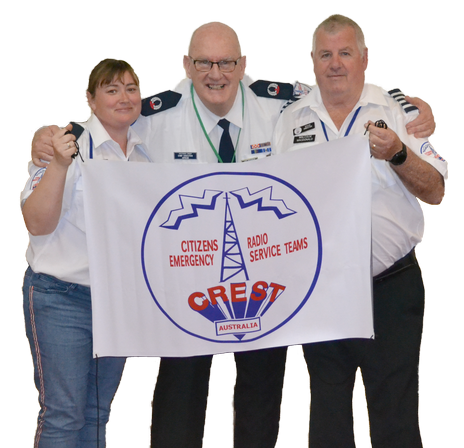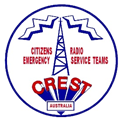Our History
Our Australian Crest History
1976 to 1978 (Pre-Legalisation)
In September 1976 a group of CB radio operators met in the Sydney suburb of Glebe. They operated radio transmitters illegally because along with a quickly growing number of CB Radio enthusiasts, the Government of the time refused to allow them access to a communications medium widely enjoyed in other parts of the world. The group decided a need existed for a radio emergency service, basically aimed at assisting the motoring public. CREST was born out of that meeting. Members of that group then formed Divisions in Sydney, Gosford, Newcastle and Tamworth.
Word spread throughout other users of the still illegal CB medium and CREST rapidly gained respect and assistance. The first emergency call was handled in October 1976.
The next area to form a Division was Canberra, this was after a visit to Sydney by the then president of the Charlie Tango CB Radio Club. The initial spread of CREST was rapid and in the first twelve months of operation CREST Divisions were formed in all States of Australia.
Despite the non-approval of some authorities, CREST gained the confidence of other emergency law enforcement bodies. A ‘blind eye’ was often turned to the source of information about an emergency.
1978 to 1988
Soon after legalisation became a reality, the National Headquarters of CREST was moved in principal from Sydney to Canberra as the growth of CREST in all States was exceeding even the most optimistic predictions. A situation indicative of this was the Northpoint Base in Sydney which was taking over 1500 calls a month on a twenty-four-hour basis.
It soon became apparent that CREST needed more emphasis placed on the financial and administrative aspects of the organisation to alleviate the heavy financial drain on Monitors, and to improve the cohesion of the vastly diverse locations and operations of Divisions in every area of Australia. To this end National CREST moved for certain Government privileges, amongst them tax deductibility and tax exemption. In 1979 a test case of expenses claims against taxation was made and favourable reactions from the Taxation Department indicated a willingness by this Department to recognise CREST as a worthwhile organisation, not just a CB club.
Incorporation was granted to the National Body on June 8, 1979 and three other States had also become incorporated by 1980. Unfortunately, difficulties with the laws in N.S.W. prevented incorporation in that State without large sums of money being spent for relatively little return. These separate incorporations tended to legally fragment CREST nationally.
Many of the State bodies decided in early 1980 to pursue ‘State-based’ management in preference to National control. This was brought about by the magnitude of administrative problems at a National level and has resulted in a sounder structure. CREST – NSW was formed mid 1980 with its own constitution.
On January 19, 1982 the Taxation Department granted Public Benevolent Institution status to CREST-NSW. CREST-NSW was officially recognised by the NSW Police Department on November 21, 1983, under the signature of the Commissioner, C.R. Abbott.
Affiliation with the Volunteer Rescue Association (VRA) took place on April 28, 1984 when the State Director put CREST’s case to a VRA meeting in Albury. Mr Phil Koperberg, representing the Minister for Police and Emergency Services, Mr Peter Anderson, announced official Government recognition on August 25, 1984.
During the 1989 – 1990’s
CREST-NSW became incorporated on December 15, 1989. In 1989 a major investigation into the NSW emergency services was conducted. This was carried out by Maj. Gen. R.A. Grey. As a result of this report the NSW Cabinet approved the major restructure of Rescue and Emergency Management Services in NSW. All emergency services in NSW must now be accredited. Official accreditation for CREST-NSW Inc. occurred in March 1990. This means that CREST-NSW Inc. is the Citizens Band radio communications group accredited to provide in-the-field communications for the volunteer and professional services in NSW.
CREST Action
On December 28, 1989, an earthquake devastated much of Newcastle. The people of Newcastle and the Hunter valley Region were required to respond to an event of urban devastation never before experienced in Australia. The Members of Newcastle CREST were instrumental in providing vital communications during this period. Receiving a State Government certificate for the Newcastle rescue operation, issued under the seal of the then NSW Premier, Mr Nick Greiner, rewarded their efforts.
Following heavy involvement in provision of communications during the Nyngan area flooding emergency in April/May 1990, CREST-NSW Inc. was awarded the New South Wales Meritorious Unit Services Award. The award was accepted on behalf of CREST-NSW Inc. by the then State Director, Trudy Hanson. This award was created by the Premier of NSW, Mr Nick Greiner, following the 1989 Newcastle earthquake, to publicly recognise the contributions made by emergency and community organisations to the people of New South Wales.
On Monday, January 21, 1991 a 40-minute storm, likened to a mini tornado, demolished a huge area of the north shore of Sydney. Damage cost was estimated at $100m. Four thousand homes were affected. The clean-up operation was under the control of Maj. Gen. Brian “Horrie” Howard. Members of Sydney and Blue Mountains CREST and other Members from throughout NSW, numbering 25 in total, worked out of SES Headquarters under Maj. Gen. Howard’s control. The magnificent efforts of those involved were rewarded by the NSW Government in presenting a Meritorious Service Award to Mr Greg Bell, representing Sydney Division, on March 10, 1991.
In January 1994 New South Wales was subjected to bushfires more serious than anything ever seen before. A State of Emergency was declared in almost every region of NSW, with fire services stretched well beyond the limit. Assistance in the form of additional fire fighters and fire tankers came from Victoria and Queensland. The Sydney, Blue Mountains and Central Coast regions of NSW were very seriously affected, with many homes being lost to the uncontrollable fires. CREST Members from throughout NSW were once again providing the emergency services with vital in-the-field communications during the crisis. The lessons learnt from the 1994 bushfires were not forgotten quickly by the residents of NSW. At the height of the emergency, ordinary communications methods were stretched to the limit leaving residents in some danger areas without telephones.
On Wednesday, July 30th 1997 at approximately 11.40 PM AEST, a landslide at Thredbo in NSW resulted in the entrapment of some 19 persons in the ruins of two ski chalets. Rescue and emergency services from throughout NSW swung into action. The role of CREST was to assist the SES in the Goulburn operations centre.
CREST Today
Today the monitoring of the emergency frequencies continues. There are numerous CB’s fitted in trucks, cars and houses throughout Australia, and these can be used to contact CREST for assistance or to relay important messages. CREST continue to prepare themselves for times when other methods of communications the fail, and the radio network and other satellite mediums could be the only communications links available.
CREST looks to the future to offer communications assistance wherever and whenever it is required. The form of assistance that CREST provides is always changing to meet the needs of the community. CREST South Australia has just been reformed and is already well on the way to obtaining a number of new and enthusiastic Communications Officers to monitor for any calls that are reported by the various people who have two-way Citizens Band radios at their disposal. Truckers, Grey Nomads, 4WD, and farmers, are just a few of the community groups who regularly utilise our services.


Join the team!
To apply for membership, simply complete the online application form . Please note that all details are kept in the strictest of confidence.
